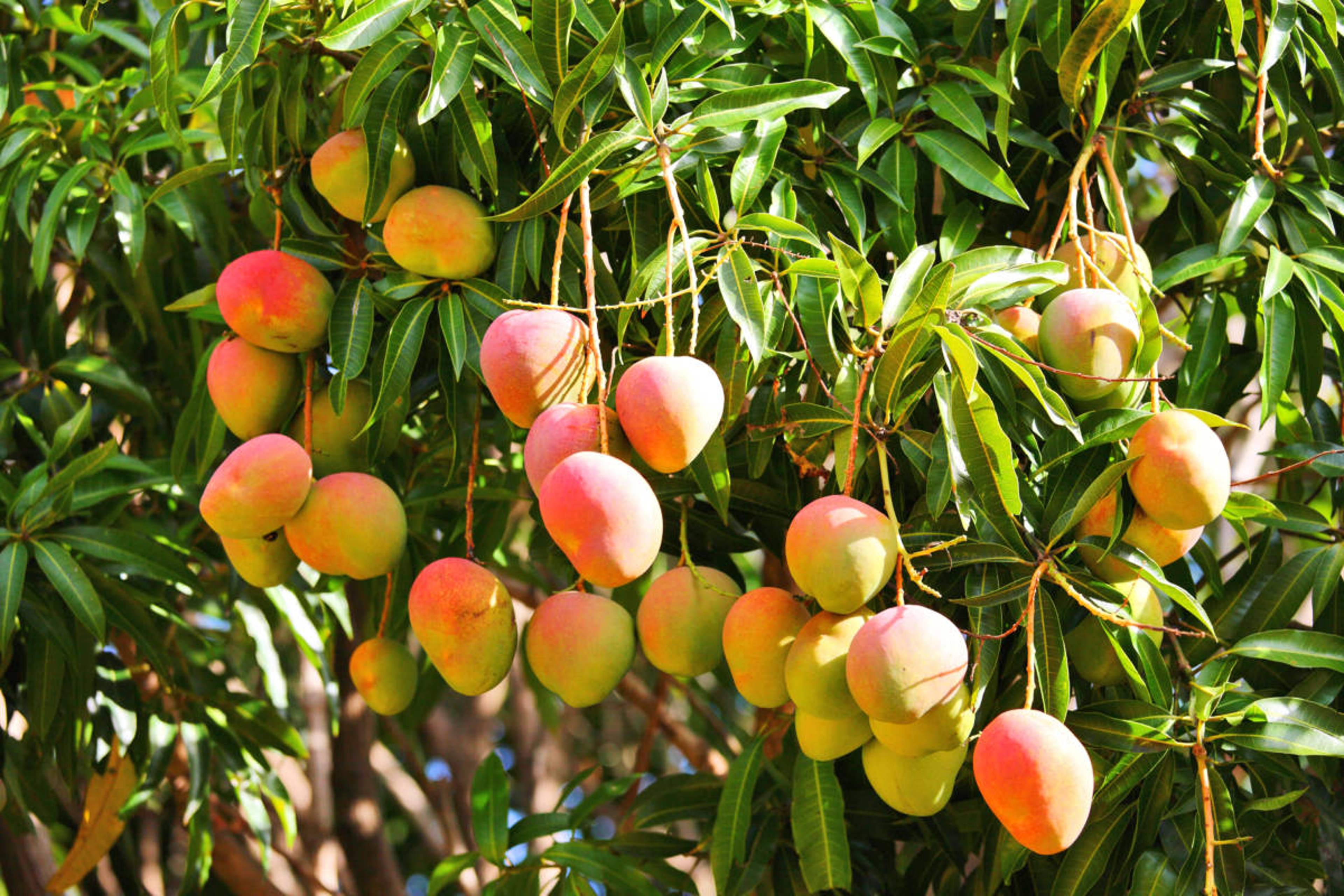10 Things You Didn't Know About Mangoes
Despite being a pain to slice and even dangerous to grow, the world loves mangoes.
Jul 30, 2021
1. Mangoes are a beloved global phenomenon
Experts estimate that more than 20 million tons of mangoes are grown and consumed around the world each year. According to Jessica Bohlman of the National Mango Board, “Mangoes are considered the most popular fruit in the world because of their incredible reach and vast cultural significance.” As proof of that international allure, she adds, “They are the national fruit of India, Pakistan, and the Philippines. They're also native to India and Southeast Asia, where they have been cultivated for more than 5,000 years.”
2. Send a mango to someone you love
“Mangoes are a symbol of love and friendship in India,” Bohlman says. Giving someone a basket of mangoes is a common sign of goodwill. “Many companies and businesses send dozens of mangoes to their clients and partners each year during mango season as a gift,” she explains.
And it's not just the fruit that's special: “Mango leaves are known to signify goodwill blessings and to deter negative energy,” Bohlman adds. “In Indian culture, mango leaves are hung in entrances and temples during special ceremonies to usher in love, good fortune, and prosperity.”
3. Mangoes like it warm
An unripe mango will absolutely refuse to ripen any further when placed in a fridge, says Jeff Wasielewski, a tropical fruit expert at the University of Florida, Miami-Dade County. Instead, he recommends keeping an unripe mango at room temperature in a brown paper bag with other fruit to help speed its ripening. As they sit at room temperature, unripe mangoes will gradually become sweeter and softer — you'll know they're truly ripe by their fragrant, pineapple-like scent and slight “give” when squeezed.
4. Types of mangoes: their variety is vast
There are thousands of different varieties of mango trees in the world, and each produces its own unique fruit. “We grow over 300 varieties of mangoes on our farm alone,” says Alexander Salazar, a mango producer and founder of Tropical Acres Farms in West Palm Beach, Florida. “The primary mangoes we find commercially in grocery stores are Tommy Atkins, which are the most common mango variety and have a dark red blush, followed by Ataulfo — honey or champagne mangoes,” he says. After that are the Haden, which is bright red with green and yellow overtones; the Kent mango, which tends to be greener and has a slightly sour, tart flavor; and the Keitt, which is found more commonly in Asian markets.
5. Give your face a healthy boost
Mangoes are incredible for your skin. Of all the vitamins and minerals you get from a mango, one of the most abundant is vitamin A — the vitamin most responsible for helping cells to reproduce properly and keeping your skin looking young and healthy, according to researchers at the Icahn School of Medicine at Mount Sinai in New York City. Mangoes are one of the leading sources of vitamin A, and half a large mango contains approximately 25% of the recommended amount most adult men and women need daily.
6. Mangoes are a steak's best friend
“Mangoes have natural tenderizing properties, which makes them perfect for marinades,” Bohlman says. Enzymes in the juice help to speed up the breakdown of proteins into amino acids, making meat less chewy, she explains. To make a fresh mango marinade, dump one freshly cubed mango in a blender with a tablespoon of oil and two tablespoons of orange juice or white wine. Add ginger, brown sugar, garlic, red chile flakes, salt and pepper, and other seasoning to taste, and process until smooth. Allow your meat to soak in the marinade for at least two hours for maximum tenderness.
7. Mangoes come from a rough family
Mango trees can be dangerous, like rhubarb stalks (which you can consume but sport a poisonous leaf) and cashews (which grow in a toxic shell).

“The sap from the mango tree contains urushiol, an oily allergenic chemical,” warns Bohlman. It's the same itch-inducing oil that gives poison ivy, poison oak, and poison sumac their power.“
Contact with urushiol by touching mango leaves or bark may cause allergic contact dermatitis — an itchy, blotchy skin condition,” she says. While this is bad news for people growing mangoes, consumers are perfectly safe: The oil doesn't appear in the fresh fruit.
8. A delight for the nose and taste buds
“Most people aren't aware of the wide spectrum of aromas and flavors mangoes can possess,” according to Salazar. “There are mangoes that taste like citrus, coconut, pineapple, even honey,” he says. “There are also mangoes with flavors similar to stone fruit, mangoes that are sweet like guava, and even mangoes with rich, spicy characteristics similar to flavors found in a pumpkin pie. The variety is astronomical.”

9. Paisley's inspiration
“The popular paisley pattern, which was originally developed centuries ago in India, is originally based on the shape of a mango fruit,” says Bohlman. The teardrop-shaped repeating pattern on textiles was first used to decorate royal regalia, crowns, and garments were meant to include popular symbols of life and eternity. That's why the paisley pattern mimics the outline of a mango, with a slightly stylized curved end as a bit of artistic license.
10. Treasure hunting
When it comes to slicing through the firm, slightly leathery skin of a mango to get to the fruit within, take heart. “There is no wrong way to cut a mango!” Bohlman says. “One popular option is to cut the fruit in half vertically, slicing about a quarter-inch away from the midline on each side of the fruit to avoid the seed,” she explains. “From there, you can cut the flesh in a gridlike pattern for the iconic hedgehog cut, or simply slice and scoop out.”
Another option that recently took the internet by storm: Use a common water glass to help with your mango peeling. For this technique, you still slice the mango along both sides of the seed, creating two halves. Then, cup your hand around the mango segment and bring it up to the rim of a sturdy glass. To peel, press gently but firmly to move the glass in between the skin and the flesh of the mango. As you push down, the peel will magically separate from the flesh, and when you finish, your freshly peeled mango will land right inside your glass.
.svg?q=70&width=384&auto=webp)







